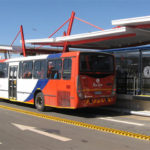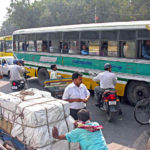Posts tagged with 'fuel efficiency'
India’s urban centers are grappling with a severe air pollution crisis that poses a significant threat to public health and urban livability. Studies suggest that each year, Delhi records approximately 12,000 air pollution-related deaths, accounting for 11.5% of its total fatalities. Despite ...

China’s transport CO2 emissions accounted for 11% of the world’s transport greenhouse gas (GHG) emissions, following only the United States (21%), according to data from Climate Watch. And these numbers have been growing rapidly: The average annual growth rate of China’s transport ...

The world’s ability to overcome the climate change challenge hinges, in part, on what happens on China’s roads. China’s cars, buses, trucks, shipping and other transport generated 828 million tonnes of greenhouse gases in 2014. That’s almost the equivalent of the EU ...

Companies like Toyota, Nikola and H2X are doubling down on hydrogen fuel cell vehicles and positioning them as alternatives to their more popular zero-emission counterparts, battery electric vehicles. These companies and some advocates believe fuel cell vehicles could be key to ...

In China, trucks dominate the freight transport market and are increasing at a fast rate. In 2014, trucks moved more than 33 billion tonnes of freight in China. This accounted for more than 75 percent of total freight movement, which ...

In 2012 alone, Latin America saw 131,000 preventable air pollution-related deaths. To reduce emissions and improve air quality, it’s essential that public transit fleets—like buses—become more fuel-efficient. Adopting cleaner fuels—like natural gas or low-sulfur diesel—and upgrading to technologies that produce ...

America’s vehicles are on the road to becoming cleaner. Last week, President Obama directed his administration to set new fuel efficiency and greenhouse gas (GHG) emissions standards for medium- and heavy-duty vehicles, including large pick-up trucks, school buses, and tractors. Improving fuel ...

Have you ever wondered what message you’re sending that special someone through how you get around? According to a recent survey, you probably should. Out of 2,000 British men and women polled by Motors.co.uk, an online facilitator for buying and ...

This is the inaugural post of a new “Sustainable Urban Transport On The Move” blog series, exclusive to TheCityFix. Ever since the mass production of automobiles began nearly a century ago, the prevailing paradigm in urban transport has been the ...

Rising natural gas prices in India have put a strain on India’s urban bus companies. Photo by Meena Kadri. In the Mumbai metropolitan region alone, over 300,000 vehicles run on compressed natural gas (CNG), including 42,000 taxis and about ...

This is the second round of a two-part series weighing the benefits of natural gas versus low-sulfur diesel as fuel sources for buses. Natural gas won Round I because when we focus on tailpipe emissions it is less toxic, and ...

Natural gas might help public transport to pollute less. It might be a cost effective solution as well. The Indian government mandated natural gas in 2004 for all public buses and rickshaws in a number of cities, but was mandating ...

Welcome to “Research Recap,” our series highlighting recent reports, studies and other findings in sustainable transportation policy and practice, in case you missed it. Asia Motorization The Asian Development Bank released its 43rd annual report tracking sustainability data and practices ...

Latin America Urbanization A United Nations report found that urbanization rates in Latin America will continue at pace until 2050, when 90 percent of Latin Americans will be urban dwellers, up from about 80 percent at present. Though this dense urbanization is found across South ...

In India, the Gujarat High Court has ordered the state government to convert all public and private vehicles registered in the state to compressed natural gas (CNG) within one year. From the court’s order: “State is directed to pass necessary ...


























